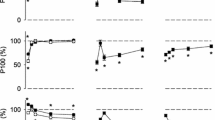Summary and Conclusions
Thirty-one male subjects squeezed a hand dynamometer as rapidly and as forcefully as possible, the effort being recorded on fast-moving paper. At the count of three the hand was released explosively. Two such testing sessions were held; following the first measurement of tension development and release the subject immersed his arm in a water bath. On one occasion it was at a temperature of 10° C, on the other of 46° C.
The subject then repeated the procedure with the hand ergograph. The force-time curves of the contraction were described mathematically by a three-component exponential equation. Very little difference existed in the rate parameters of the normal and hot conditions, but these parameters were markedly slowed by the application of cold. This was further reflected in the contributions that each component made to the total work integral. Similar results were obtained during the release phase; the rates were nearly identical for the normal and hot curves, but two or three times slower for the cold. The steady state force level, compared
with the normal, was significantly increased under the hot condition and significantly depressed under the cold.
Similar content being viewed by others
References
Clarke, D. H.: Strength recovery from static and dynamic muscular fatigue. Res. Quart.33, 349 (1962).
Dern, R. J., J. M. Levine andH. A. Blair: Forces exerted at different velocities in human arm movements. Amer. J. Physiol.151, 415 (1947).
Grose, J. E.: Depression of muscle fatigue curves by heat and cold. Res. Quart.29, 19 (1958).
Ralston, H. J., M. J. Polissar, V. T. Inman, J. R. Close andB. Feinstein: Dynamic features of human isolated voluntary muscle in isometric and free contractions. J. appl. Physiol.1, 526 (1949).
Rich, G. Q.: Muscular fatigue curves of boys and girls. Res. Quart.31, 485 (1960).
Royce, J.: Maximal work capacity of human intact muscle under hyperaemic conditions. Res. Quart.31, 505 (1960).
—: Force-time characteristics of the exertion and release of hand-grip strength under normal and fatigue conditions. Res. Quart.33, 444 (1962).
Walker, S. M.: The relation of stretch and of temperature to contraction of skeletal muscle, Part II. Amer. J. phys. Med.39, 234 (1960).
Wilkie, D. R.: The relation between force and velocity in human muscle. J. gen. Physiol. (Am.)110, 249 (1949).
Author information
Authors and Affiliations
Additional information
This study was supported by a grant from the Berkeley Faculty Research Fund of the University of California, Berkeley.
Rights and permissions
About this article
Cite this article
Clarke, D.H., Royce, J. Rate of muscle tension development and release under extreme temperatures. Int. Z. Angew. Physiol. Einschl. Arbeitsphysiol. 19, 330–336 (1962). https://doi.org/10.1007/BF00694275
Received:
Issue Date:
DOI: https://doi.org/10.1007/BF00694275




